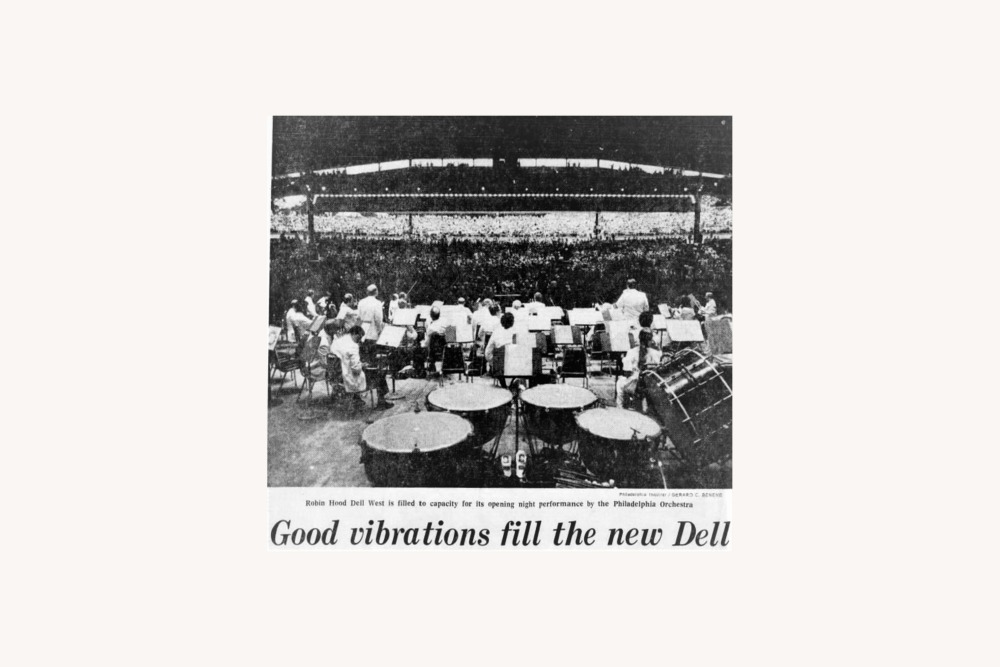From the Vault: Opening of the Robin Hood Dell West (1976)
MANN MUSIC ROOM: VAULT
Blog Entry by Jack McCarthy, Historian, The Mann Center for the Performing Arts
The Mann Center traces its history to the Robin Hood Dell, which opened in 1930 in East Fairmount Park as a summer home for The Philadelphia Orchestra. In 1976 the organization moved to a new venue in West Fairmount Park. Originally called Robin Hood Dell West, it was later renamed the Mann Music Center in honor of its longtime director and benefactor Frederic Mann, and subsequently renamed the Mann Center for the Performing Arts.
The opening of the new Robin Hood Dell West in June 1976 was many years in the making. The original Robin Hood Dell, which opened in 1930 on the east bank of the Schuylkill River in East Fairmount Park, was a beloved venue but presented problems. The most challenging was the weather. As an open-air venue, the Dell was at the mercy of summer storms that often swept through Philadelphia, wreaking havoc on concert scheduling and attendance. Even the threat of bad weather would keep audiences away. Another major problem came with the opening of the Schuylkill Expressway in 1958. Located just a few hundred yards from the Dell on the west bank of the river, the Expressway’s constant traffic noise was a major distraction for audiences and musicians alike. These and other factors led the Dell board, led by its indefatigable president Frederic Mann, to seek another location.
Serious planning got underway in the early 1970s. The site selected for the new venue was George’s Hill, an expansive sloping area in West Fairmount Park, adjacent to the neighborhood of Parkside. City and state funding was appropriated in 1974, construction began in February 1975, and the facility was ready by June 1976, just in time for the celebration of the US Bicentennial, when all eyes would be on Philadelphia. Called “Robin Hood Dell West” to distinguish it from the original Dell, which was renamed “Robin Hood Dell East,” the new venue had 5,000 seats under cover, another 5,000 seats outside the covered area, and space for an additional 5,000 on the lawn behind the seats.
The inaugural concert was June 14, 1976, with music director Eugene Ormandy leading The Philadelphia Orchestra in a star-studded program. Ormandy, who had been the first guest conductor at the original Dell in 1930, was marking his fortieth year with the Orchestra. Surprisingly, the concert did not include any American music in honor of the Bicentennial; both the program and the featured soloists were all European. The soloists included violinist Isaac Stern, cellist Gregor Piatigorsky, and pianist Vladimir Ashkenazy, all renowned concert artists of the time. The concert opened with Ormandy leading the Orchestra in Ludwig van Beethoven’s Leonore Overture No. 3, followed by Stern and Piatigorsky performing Johannes Brahm’s Double Concerto. After intermission, Ashkenazy performed Sergei Rachmaninoff’s Piano Concerto No. 3.
The new facility received mixed reviews. In terms of aesthetics, the consensus was generally favorable. The Philadelphia Inquirer entertainment writer described the new venue as “a bold, sweeping structure, featuring a copper alloy metal skin and a warm, dimensional cedar interior,” while the paper’s music critic stated that “No one could say the theater fell below expectations in its appearance. The cedar facing of the orchestra stage and throughout the theater lends visual warmth and provides the sense of nobility a hall should have.” Most of the negative reviews concerned problems with the acoustics, which all agreed could be rectified with adjustments and fine tuning. This is, in fact, what happened in the months and years that followed. The venue’s acoustics are now highly regarded.
Some critics also took issue with the fact that the paid seats were under cover while the free seats were exposed to the elements. All Robin Hood Dell concerts had been free since 1953: attendees clipped out coupons that were published in the newspapers and mailed them in to receive their tickets. However, there was also a “Friends of the Dell” group who paid for annual subscriptions and were given reserved seats in the front. Their support was critical to the Dell’s financial stability. In the old Dell, everyone was exposed to the elements equally, but in the new Dell the paid subscribers took up the entire 5,000-seat covered area in the front. Some claimed that this was contrary to the Dell’s philosophy of making good music equally accessible to all, while Frederic Mann countered that the facility could not have been built without the support of the Friends and that the Dell was the only major concert venue in the nation that made its entire season free to the public. Such were the challenges of building and operating a first-class outdoor concert venue in a major American city in the late twentieth century.
Just as Philadelphia celebrated the opening of the new Robin Hood Dell West during the US Bicentennial in 1976, it will celebrate the venue’s fiftieth anniversary during the nation’s 250th anniversary in 2026. Again, all eyes will be on Philadelphia.



